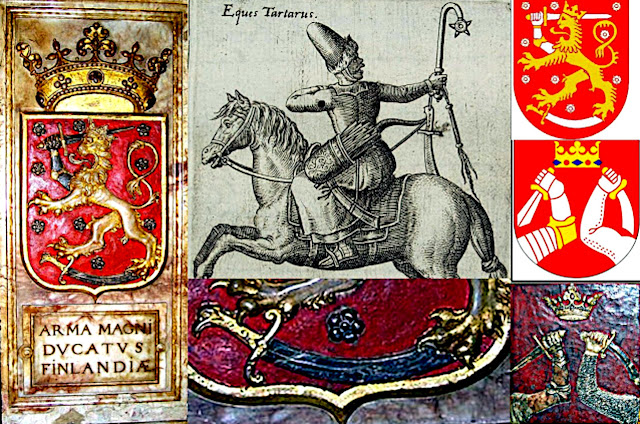'Finn' and 'land' are both more than 2,000 years old - and first applied to northern Europe settled by different types of Finns
Peter
Klevius tries to correct the scientific bias that population gravity
and PC, rather than essence and honesty, has created.
Finland - the motherland* of Sweden, Norway, Denmark, Holland, England, Scotland, Ireland etc.
The muslim scimitar against the Western "infidel". Or today, Saudi
islamofascism (Saudi based OIC sharia) against Human Rights. This has
been made possible by OIC officially abandoning Human Rights in 1990,
and EU's s.c. Mediterranean treaty that paved the way not only for an
unregulated immigration of muslims from Middle East and Africa, but also
for the stifling of criticism against islam (compare OIC's urge to
criminalize the new "illness" it had diagnosed and called
"islamophobia").
The scimitar on Finland's and Karelia's coat of arms symbolizes the evil
of islam - not Russia* (although Ivan was terrible, he wasn't an
ideology).
Before the appearance of the scimitar trampling lion on the coat of arms
of Finland, muslim Tatar warriors (on the pic) carrying scimitars*
repeatedly attacked and pillaged the southern coast of Finland with
devastating effect on the locals.
* Tatars used by Russia (Muscovite) carried Cossack style sabers, not
scimitars.
Finland's coat of arms (top right) is first known from the 1580s (on
Gustav Vasa's tomb in Uppsala cathedral), while the Karelian coat of
arms (below Finland's) was seen already in 1562. Uppsala cathedral was
built after the Viking age on top of Sweden's original sacred
non-Christian site. Uppsala was the natural and closest connection from
Finland via the archipelago (see Peter Klevius Finland-Swedish history
lesson about Kvenland).
The symbol of the lion is derived from the coat of arms of the Folkunga
family, and included in the royal arms of Sweden. The beginning of the
Folkunga family is said to be traced to Fornjotr, the King of Kvenland
and Gotland (ca 160-240 AD).
Finland-Swedish Leif Tengström made a desperate 1,000 page long effort
in his thesis Muschoviten-- Turcken icke olijk": Ryssattribut, och deras
motbilder, i svensk heraldik från Gustav Vasa till freden i Stolbova
(1997 - ("The Muscowite, not unlike the Turk" : Russian attributes in
Swedish heraldry from Gustavus Vasa [1523] to the peace-treaty of
Stolbova [1617]. Diss. -- Jyväskylä University) - trying to disprove a
much better Finland-Swedish historian, Matti Klinge, who already 1981
established the scimitar on the weapon as representing muslims.
Tengström vehemently opposed this view but after a decade long research
he had to admit his failure but covered it up in a charlatanic excuse,
i.e. that the scimitar just represented a general western xenophobia
against both Russia and islam. In fact, Tatar warriors were all over the
place, even fighting for the Muscovites, but they can't possibly have
been the prototype for the muslim scimitar on the coat of arms.
Tatar muslim warriors were sent to Arabia to learn how to hate
"infidels" - and then utilized by a Swedish/Polish king (Sigismund II
Augustus) who said he "liked the muslim way of keeping with old
customs".
Peter Klevius: Reminds me of how the islamofascist Saudi dictator family
still today uses the old islamic method of "teaching" hate against the
"infidels" (compare Rohyngia jihadis, Sri Lankan jihadis, Uyghur jihadis
etc. - or just any Sunni jihadi all over the world.

No comments:
Post a Comment